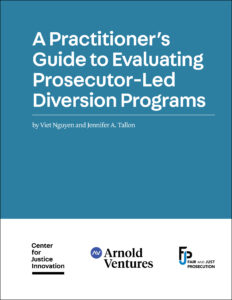-
Viet Nguyen
-
Jennifer Tallon

Jennifer Tallon
As an alternative to traditional prosecution, diversion programs are a key policy lever that prosecutors can use to minimize harmful criminal legal system contact. Diverting a person out of the system as early as possible can help to maintain public safety, preserve scarce resources, and reduce future system involvement.
However, assessing the effectiveness of diversion programs can be challenging. Because diversion program participants are generally different from other individuals involved in the criminal legal system, it can be hard to determine whether changes in outcomes are driven by the diversion program itself or participants’ background characteristics.
For agencies seeking to assess and document program efficacy, our guide provides an overview of the key data elements, types of study designs, and the questions to consider. Agencies can use the findings from well-designed, rigorous evaluation endeavors to inform major decisions like program operations and how to improve services. For example, a well-designed study can inform programmatic details like changing diversion conditions, reconfiguring eligibility criteria, or even shifting resources to another more promising program.


